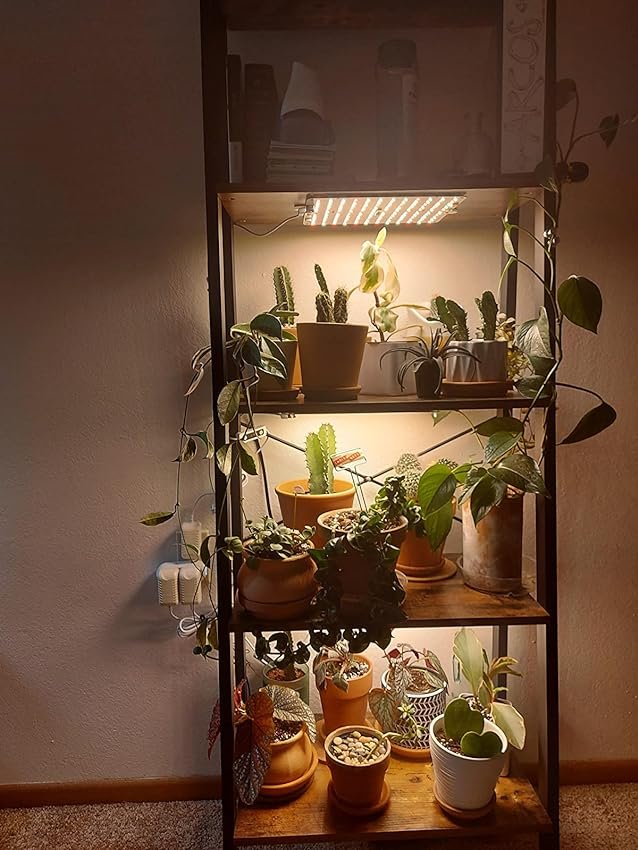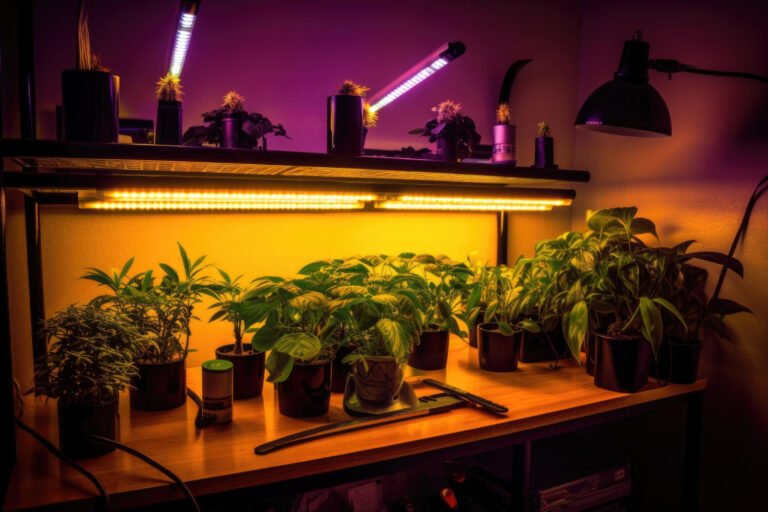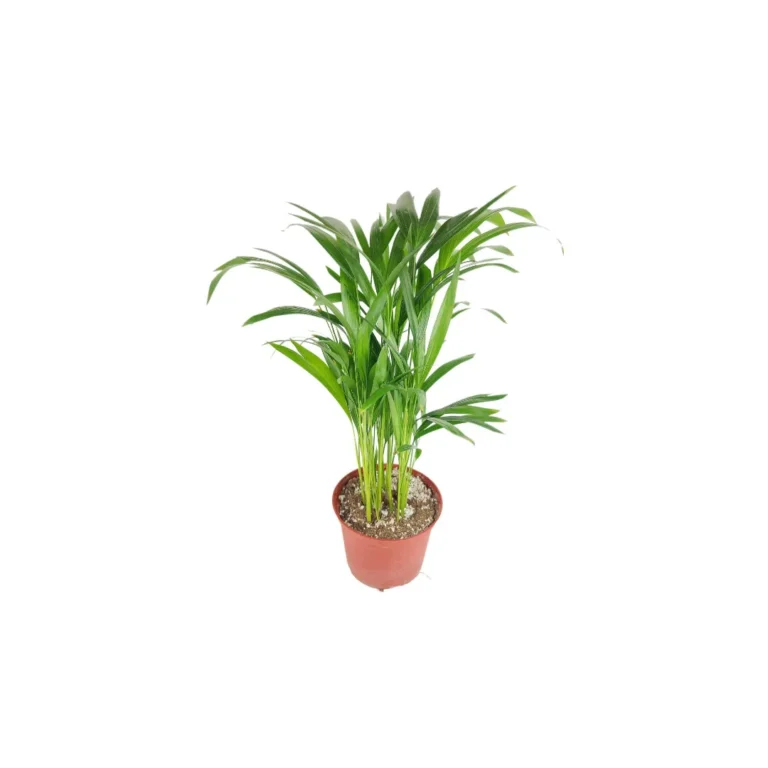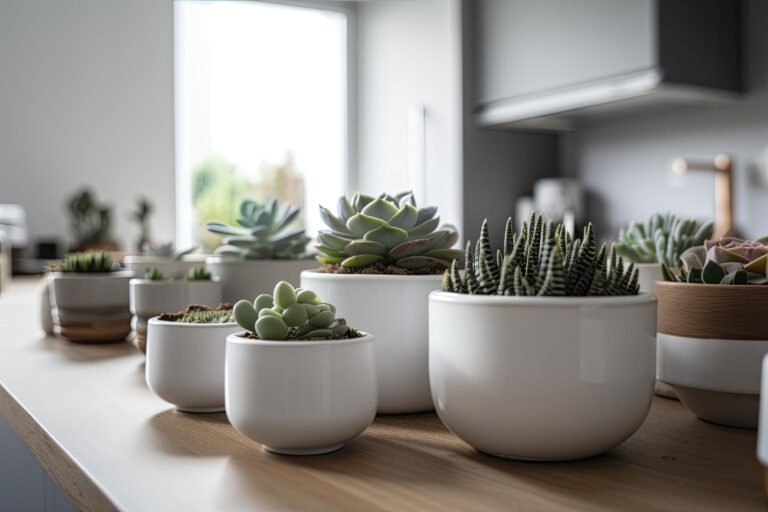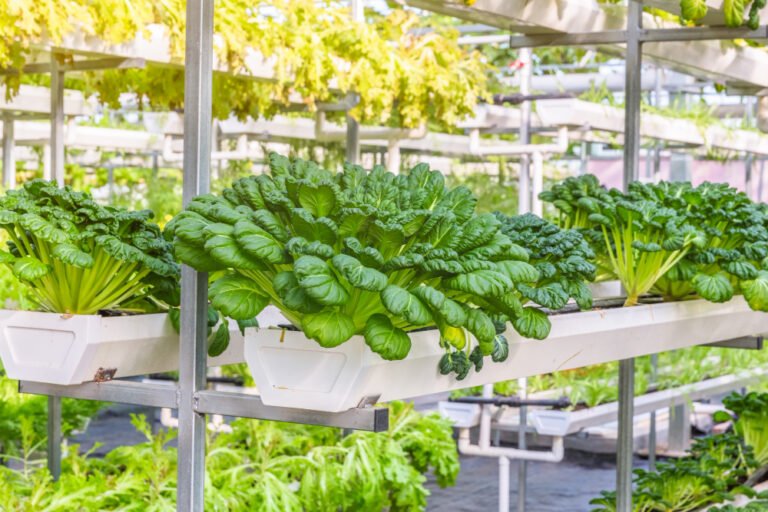Are you wondering how to use grow lights for indoor plants? This question is more common than you might think, especially for those new to the indoor gardening world.
The answer is simple: grow lights supplement or replace natural sunlight for plants growing indoors. They provide the specific light spectrum needed for photosynthesis, promoting healthy growth and development of healthy plants.
We are all about creating the perfect environment for my green buddies to thrive, and one thing we’ve learned is that proper lighting is key, especially for indoor plants. So, we went on a personal research adventure to explore the wonderful world of grow lights.
Through personal experience, we have gained valuable knowledge and practical skills in selecting and utilizing grow lights within each of our homes. As a result, we are now able to provide the optimal growth environment for our plants.
Using Grow Lights for Indoor Plants
Understanding the Importance of Light for Plant Growth
Plants need light to carry out photosynthesis, a process that converts light energy into chemical energy, promoting plant growth and development. Without enough natural light, indoor plants can benefit from artificial light sources, such as grow lights.
Grow lights are designed to emit the precise wavelengths of light that plants require for photosynthesis. They are especially useful in areas with limited or no access to natural sunlight, or during winter when daylight hours are shortened.
Types of Grow Lights
When choosing a grow light, it is important to consider the type of plants you are growing, their growth stage, and your budget. Make sure to also properly use and maintain your grow lights to avoid any common mistakes that may harm your plants.
Several types of grow lights are available, each with its advantages and disadvantages. The most common types include fluorescent tubes, incandescent bulbs, and LED (light-emitting diode) grow lights.
Incandescent Grow Lights
These are the least expensive grow lights available in the market. They emit a bright red light which is great for flowering plants. However, they are not energy-efficient and can burn plants if placed too close.
Fluorescent Grow Lights
These are a popular option for indoor gardeners. They are energy-efficient and emit a cool white light that is great for seedlings and young plants. They are also affordable and come in different sizes and shapes.
High-Intensity Discharge (HID) Grow Lights
These are the most powerful grow lights available in the market. They emit a bright light that is ideal for large plants. They come in two types: Metal Halide (MH) and High-Pressure Sodium (HPS). MH lights are great for vegetative growth while HPS lights are great for flowering.
Light Emitting Diode (LED) Grow Lights
These are the most energy-efficient grow lights available in the market. They emit a full spectrum of light that is great for all stages of plant growth. They are also long-lasting and do not produce excessive heat.
Plasma Grow Lights
These are the newest type of grow lights available in the market. They emit a full spectrum of light and are great for all stages of plant growth. They are also long-lasting and energy-efficient. However, they are quite expensive and not widely available.
The Role of Light Spectrum
Light sources emit a spectrum of different wavelengths of light. For photosynthesis to occur, plants need particular wavelengths of light.
Blue light
This type of light is essential for plant growth as it stimulates the production of chlorophyll. Without chlorophyll, plants cannot carry out photosynthesis, which is critical to their survival and growth.
Red light
Red light is important for the reproductive stages of plants, such as flowering and fruiting. It helps to trigger the production of hormones that stimulate these processes.
Green light
Although not as critical as blue and red light, green light still plays a role in plant growth. It aids in the development of leaves and stems by allowing plants to absorb more energy from the sun.
UV light
While too much UV light can be harmful to plants, small amounts can be beneficial. UV light helps to increase the production of flavonoids, which are compounds that protect plants from environmental stressors.
Infrared light
This type of light is not visible to the human eye, but plants can still absorb it. Infrared light helps to regulate plant growth and development by stimulating the production of certain enzymes., such as blue and red light. Green light aids in the growth of leaves and stems, while red light stimulates flowering and fruit production. Grow lights have the ability to replicate the natural light spectrum of the sun by emitting a comprehensive range of light.
How to Choose the Right Grow Light for Your Indoor Plants
Choosing the most suitable grow light for your indoor plants relies on various factors, such as the specific types of plants you are cultivating, their individual light needs, and the dimensions of your indoor garden.
Understanding Your Plants’ Light Requirements
Different plants have different light requirements. Some plants, like succulents and cacti, require more light, while others, like ferns and snake plants, can thrive in lower light conditions. It’s essential to research the specific light needs of your plants to choose the right grow light.
For instance, flowering plants typically require more red light to promote flower’s blooming. On the other hand, foliage plants benefit more from blue light, which encourages leafy growth.
Considering the Size of Your Indoor Garden
The size of your indoor garden also plays a role in the type of grow light you should choose. A single bulb or a small panel of LED lights might be sufficient for a small collection of plants or a single plant. However, you might need a more extensive grow light system for larger indoor gardens or for those growing plants indoors that require a lot of light, such as tomatoes or peppers.
How to Use Grow Lights Effectively
Once you’ve chosen the right grow light, it’s important to use it effectively to ensure your plants thrive. Here are some tips on using LED grow lights and how to do that.
Positioning Your Grow Lights
The position of your grow lights can greatly affect the growth of your plants. The lights should be close enough to provide enough light intensity but not so close that they cause heat damage. As a general rule, fluorescent bulbs and LED lights can be placed closer to plants than incandescent lights, which produce more heat.
Determining the Right Amount of Light
Determining the right amount of light for your plants is a balancing act. Too little light can lead to weak, leggy plants, while too much light can cause leaf burn.
Most houseplants thrive with 12-16 hours of light a day. However, the specific needs can vary depending on the plant species. It’s always a good idea to start with the recommended light duration for your specific plants and adjust as necessary based on the plant’s response.
The Role of Color Temperature in Indoor Gardening
Color temperature, measured in Kelvin (K), refers to the appearance of light produced by a light bulb. It plays a crucial role in indoor gardening as different color temperatures and light intensity can influence plant growth.
Understanding Color Temperature
In the context of grow lights, color temperature can be thought of as the color of the light emitted by the bulb. It ranges from warm (red-yellow) to cool (blue) light. Lower color temperatures (2000K-3000K) produce a warm light rich in red and some yellow light wavelengths, while higher color temperatures (5000K-6500K) produce a cool light rich in blue wavelengths.
The Impact of Color Temperature on Plant Growth
The color temperature of your grow lights can impact how your plants grow. Blue light, associated with higher color temperatures and sunlight, promotes vegetative growth, making it ideal for leafy greens and seedlings. Red light, associated with lower color temperatures, encourages flowering and fruiting, making it ideal for flowering plants.
For most indoor gardeners, a full-spectrum light bulb that balances cool and warm light is often the best choice. These bulbs provide all the light colors necessary for plants to grow and thrive.
Final Thoughts
By now, you should have a solid understanding of how to use grow lights for indoor plants. You’ve learned about the importance of light for plant growth, the different types of grow lights available, and the role of the light spectrum in plant development and foliage growth. You’ve also discovered how to choose the right grow light based on your plants’ needs, your indoor garden size, and how to use these lights effectively.
Remember, the key to successful indoor gardening with grow lights is understanding your plants’ specific needs and adjusting your lighting accordingly. With the right grow light and proper care, you can create an indoor garden that flourishes, regardless of the season or the amount of natural light available.
So, don’t let a lack of sunlight stop you from growing your favorite plants indoors. With the help of grow lights, you can enjoy the benefits of indoor gardening all year round. Happy gardening!
Frequently Asked Questions
Q: Can I leave grow lights on 24 hours a day?
A: No, plants need a period of darkness to rest and carry out other biological processes. Most plants do well with 12-16 hours of light a day.
Q: Can regular light bulbs be used as grow lights?
A: While regular light bulbs can provide some light for plants, they often don’t provide the full spectrum of light that plants need for optimal growth. Grow lights are specifically designed to meet these needs.
Q: How many hours a day of light do seedlings need?
A: Seedlings generally require 14-16 hours of light per day. Supplemental light and a timer can help the growing seedlings and ensure they get the right amount of light.
Q: Are LED lights better than fluorescent lights for growing plants indoors?
A: LED bulbs and fluorescent lights can effectively grow plants indoors. However, LED lights are more energy-efficient and have a longer lifespan than fluorescent lights.
Q: Do all plants need the same amount of light?
A: No, different plants have different light requirements. Researching the specific light needs of each plant species in your indoor garden is essential.

